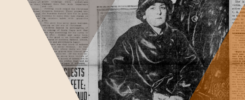Transcript for Episode 10 of the 2023 Season of Talking Hoosier History
Written by Nicole Poletika. Performed by Justin Clark. Produced by Jill Weiss Simins.
As they awaited the fate of Black Indianapolis resident Minor Moon, a legion of anxious men spilled down the stairs of the municipal courtroom, surrounded by patrolmen. Judge Paul Wetter had decided: Moon would pay $50 for trespassing—an almost unfathomable fine for November 25, 1930, especially for a man recently evicted from his home during the Great Depression. With this sentencing, Theodore Luesse—a white strike-leader in his mid-20s—cried from the front of the court room, “Comrades are we going to stand for this miscarriage of justice?”
His comrades, still lining the stairs, responded, “We want justice!” They rushed back into the courtroom, where they exchanged blows with police officers, resulting in broken doors. Luesse’s comrades, unemployed men attracted by the revolutionary promise of communism, eventually fled, leaving Luesse and labor organizer R.M. Spillman among the officers. Police swiftly escorted Luesse and Spillman to jail, where, from their cells, they cried “injustice!” and “downtrodden proletariat!”
This would be one of dozens of arrests of Luesse for his role in agitating for better living and working conditions during the Great Depression. His actions would eventually culminate in a sentence at the notorious State Penal Farm in Putnamville, known as the “Black Hole of Indiana.” From this bleak environment, Luesse ran for governor on the Communist ticket. While the gubernatorial campaign inevitably failed, calls for Luesse’s release from imprisonment, for what many decried as simply exercising his “freedom of speech,” endeared widespread public support, including from Indianapolis businessmen like Franklin Vonnegut and clergy like Dr. Frank S. C. Wicks, as well as non-partisan groups like the ACLU. His sentence also, to the dismay of judicial and government officials, increased Hoosiers’ interest in communist ideals and ignited a series of social protests. Luesse’s story illustrates that when institutions fail to meet the needs of citizens, sometimes those citizens will seek recourse extrajudicially during periods of upheaval.
I’m Justin Clark, and this is Talking Hoosier History.
Born in 1905 in Batesville to German immigrants, the future firebrand Theodore Leusse experienced hardship almost from birth. When his mother died shortly after his first birthday, his father, likely grief-stricken and needing to provide for the family, moved to Indianapolis, where he varnished furniture in a factory. Leusse’s sisters were sent to an orphanage, and Leusse moved in with his aunt on a Batesville farm. The family reunited a few years later, when his father brought his children to the capital city. There, Leusse recalled his father returning from work exhausted and sweaty, having undertaken grueling labor for mere pennies. Young Leusse tried to supplement this income with various jobs, like selling pieces of rags.
This struggle likely informed Luesse’s later work as an organizer, as did attending local political meetings with his father. After dropping out of school in his early-teen years, Luesse got a job at Western Union, where he led his first strike. He organized fellow employees under the age of 16 to demand wages equal to that of older teenagers. Here, he demonstrated his signature mix of intimidation and organizational prowess, threatening and sometimes employing physical harm against anyone who refused to strike. His tactics proved successful in raising wages.
Let’s take a quick break from our story to discuss how we pieced together the inimitable life of Theodore Luesse, made more difficult by the fact that at some point in his life he adopted the alias “Jim Moore.” While browsing books in the stacks of the Indiana State Library, IHB historian Nicole Poletika stumbled upon a book titled How I Got Out of Jail and Ran for Governor of Indiana: The Jim Moore Story. Intrigued, she read through the 1995 publication, essentially an oral history interview about his life. Wondering if such a sensational story could be true—and remained buried for so long—she consulted U.S. Census records and newspaper articles from the period. These typically corroborated Luesse’s memories and allowed Poletika to piece together a complex outline of his life and gain a more nuanced view of Hoosier responses to the Great Depression. But back to agitating…
Around 1930, Luesse joined the Communist Party, learning about local cases of unemployment and evictions through the party’s paper. Giving up a house-painting job, Luesse focused solely on combatting the deprivations wrought by the early months of the Great Depression. He organized “flying squadrons,” groups of men who traveled to welfare and unemployment offices to ensure that the agencies were meeting people’s needs. He and his comrades also distributed copies of communist papers and delivered speeches at factories like the Kingan meat packing plant. Such speeches attracted a crowd of onlookers. Some of these folks joined organizers, parading to houses where residents were being evicted. They hauled furniture back into renters’ homes, relying on a “security squad” comprised of military veterans, to intimidate police if they tried to intervene.
Luesse helped organize the Communist-based Unemployment Council of Indianapolis because, he said, the jobless had received:
“very little help from these organizations like the Socialist Party, the Workman’s Circle, and the Death Benefit Society. They were evolutionary and we were revolutionary. The Socialist Party believed that you could get everything on a ballot.”
The Unemployment Council, however, embraced public demonstrations and confrontations with public officials. Luesse contended that such direct action was necessary in early 1931, as the socioeconomic privilege of lawyers, judges, and lawmakers shielded them from the realities of daily life for the unemployed.
According to Bradford Sample’s 2001 Indiana Magazine of History article, Hoosiers received minimal help from the local or state government, relying instead on aid from civic and charitable organizations during the early years of the Depression. Espousing traditional Hoosier principles of small government and self-sufficiency, Republican Governor Harry G. Leslie refused to authorize relief bonds. In fact, he balked at requests to call a special legislative session for unemployment relief. He also refused to accept federal funds, viewing them as a threat to state autonomy.
As inaction pitched Hoosiers further into destitution, public protests intensified. On January 6, 1931, Luesse and Council members led hundreds of unemployed men to the statehouse. About 60% of protesters were Black men, who suffered from even higher rates of unemployment due to racial discrimination . They failed in their attempt to meet Governor Leslie, whom they’d hoped would reconsider his stance on relief and housing. After this, Luesse led the men, desperately in need of warmth, to Tomlinson Hall. The group hoped to find work there, as the hall housed the Office of the Unemployed.
The marchers approached the building, chanting “When we see a cop we use him for a mop.” They immediately encountered a police squadron at Tomlinson Hall, which culminated in a clash like that in the municipal courtroom. Banners bearing slogans like “Deliver Us From Starvation” soon littered Delaware and Market Streets as some marchers fled and others attempted to occupy the hall. Luesse alleged that police officers threw him on top of the gatherers and then motioned for automobiles to cut through the crowd. After sustaining a blow to the nose, police again hauled him to jail, for what he proudly proclaimed was his twenty-eighth ride.
So why is Luesse’s story significant today? Such conflicts demonstrated the painful dichotomy between the urgency of citizens’ needs and the inadequacy or unwillingness of government and civil society to meet them. The fraught circumstances are likely why some lawyers continued to aid Luesse and why Judge Paul Wetter was fairly lenient in his punishment of him. During their many courtroom encounters, Luesse and Judge Wetter exchanged perspectives, both seemingly perplexed by the other’s stance. Judge Wetter wanted to know why Luesse engaged in such provocation, and Luesse asked why Judge Wetter sentenced Hoosiers the way he did. Luesse recalled telling the judge:
“‘There was this here old man that stole a pig and you put him one hundred and thirty days on the rock pile [meaning penal farm]. You didn’t ask him why he stole the pig. You didn’t ask him about anything, but because of the fact that the law says that he should go to jail for one hundred and thirty days for stealing a pig you sent him. . . Now he’s got four breadsnappers at home.’”
Apparently he earned Judge Wetter’s begrudging respect because, according to Luesse, Wetter ordered the turnkey to release him.
Luesse employed another tactic to draw attention to the plight of Hoosier families. A “Mrs. Allen,” whose husband was unable to work due to tuberculosis, and her four children, were facing homelessness. Luesse convinced her to participate in a demonstration on the state house lawn in order to get a house. He and his comrades transported a dilapidated house to the grounds and distributed leaflets encouraging people to observe Mrs. Allen try to care for her children and complete routine tasks with meager resources. Based on the publicity generated by the demonstration, Luesse was able to secure permanent housing for the Allen family.
Throughout the spring, Luesse returned to jail several times for halting evictions and leading public demonstrations. His luck ran out after his thirty-fourth arrest, and he finally faced legal consequences. Judge Frank P. Baker sentenced Luesse to one year at a penal farm in Putnamville, stating:
“‘no man has the right to take the law into his own hands. Any such man is a menace to society. I believe this man has tried to stir up resistance against the law and create disrespect for it, which in turn might lead to dangerous riots.’”
“Oh, Goddman, that was a hell of a place,” Luesse recalled about the jail. In a sweltering quarry, he worked alongside men incarcerated for a spectrum of transgressions, including drunkenness and theft. He alleged that other men were assigned to the labor camp simply because of racial profiling. One man reportedly died because of the brutal work environment, a tragedy Luesse tried to expose by tying a letter to a kite in an attempt to smuggle it outside of the penal farm. For this attempt, he was placed in “the hole” for 20 days, where guards handcuffed and strung him from a door for hours. Such allegations were confirmed by former prisoners, who presented Governor Leslie with affidavits testifying to such treatment.
The support Luesse engendered via his activism endured throughout his incarceration, as downtrodden Hoosiers continually demanded his release. His case reportedly caused nationwide protests, and hunger marchers en route to Washington, D.C. stopped at the Putnamville prison farm, demanding to see Luesse. Rebuffed, the marchers’ automobile detachment continued on to Indianapolis, where they attempted to confront Governor Leslie about Luesse’s release and about authorizing relief for the unemployed. By the spring of 1932, prominent Indianapolis clergymen and business leaders signed a petition for the Hoosier communist’s release. Indianapolis citizen Samuel Nathanson appealed to the governor after Luesse—who happened to be born with the unique “No. 1 count”—donated pints of blood to his sick daughter in an attempt to save her life. Although Nathanson did not share Luesse’s political ideology, he felt that Luesse’s punishment did not fit the crime, and that his generosity demonstrated his fitness as a citizen.
After these efforts failed, local women led the charge to free Luesse. In April, they organized a protest of about 100 supporters at the statehouse and defied police orders to relocate to Military Park. The Lake County Times reported that officers had to forcefully remove a number of women who had climbed the building, arresting three of them. In July, a similar protest materialized at the statehouse, this time organized by unemployed men from The Region, who sought relief measures and the release of Luesse.
Given the apparent futility of such demonstrations, organizers hoped to effect change through electoral politics. In 1932, the Communist Party nominated Fay Allen for Secretary of State, Hammond activist Wenzel Stocker for Lieutenant Governor, and Theodore Luesse, still serving time at the penal farm, for Governor. Luesse reported that some guards were sympathetic to his cause and even supported his gubernatorial run. The candidates earned the public’s sympathy and respect, but not their electoral support, as borne out by the 1932 returns.
Despite this loss, Luesse and his comrades increased interest among Hoosiers in the Communist Party. Luesse’s imprisonment and the suppression of free speech wrought by his incarceration helped the Party grow exponentially. While Hoosier voters did not forsake the two major parties, they did signal the desire for change by electing the state’s first Democratic governor in 20 years, Paul V. McNutt. Indiana’s new head of state had apparently been sympathetic to Luesse’s plight and in March of 1933 released him from Putnamville.
Dogmatic as ever, Luesse returned to Indianapolis the day after he left the penal farm. He stood on the courthouse steps before an audience of 200 women and men, most of whom the paper noted were Black, and urged mass action. Upon request, he made similar speeches in cities like Evansville, Munster, Marion, and Hammond. He also worked with volunteers to organize a C.I.O. branch.
By 1935, Indiana officials could breathe a bit easier, as Luesse had transferred his organizational talent to other midwestern cities, like Belleville, Illinois. Sometime after leaving Indiana, Luesse assumed the alias “Jim Moore” and worked as a machinist. After decades of activism, Moore joined his son, Stan, in San Francisco around 1967, circulating leaflets in protest of the Vietnam War. There, he also fought for equal representation in law enforcement, housing for people experiencing homelessness, and aid for the unemployed.
Moore passed away in 2005, just weeks after his 100th birthday. Despite playing a large role in Indiana’s labor tradition and making an indelible impact on his native state during the Depression, he has largely been forgotten. Crusaders like Luesse helped modernize Indiana government and cultivate a new generation of organizers, who demanded more from their government during those tumultuous years.
While some Hoosier leaders disapproved of Luesse’s resistance, it helped catalyze necessary change during unprecedented circumstances. After all, the New Deal was not a foregone conclusion and many state lawmakers were slow to recognize the scope of constituents’ needs. Luesse’s public protests and his vociferous criticism of Governor Leslie’s inaction infused some Hoosiers with the spirit of reform. Primed for change, voters decided not to support Republican candidates to another term, instead electing progressive candidate Paul V. McNutt in 1932.
Luesse’s unflinching demand for accountability and relief measures may resonate, as Americans grapple with the current spike in inflation, swelling gas prices, the mounting student loan debt crisis, and post-pandemic housing displacement. Certainly, those who support a social safety net relate to Theodore Luesse’s belief that:
“Everybody has the right to live just because they are alive, and in order to live, a person has to have food, clothing and shelter, health and education. When he doesn’t receive that by his own ingenuity it is necessary for the government to help him.”
If you want to learn more about Theodore Luesse, visit the Indiana History Blog to read “The Agitator: Theodore Luesse Takes on the Great Depression” by IHB historian Nicole Poletika. This episode is based on her post and we’ll put the link in the show notes.
State Historical Markers are also a great way to learn more about Hoosier responses to the Great Depression. Head over to our website in.gov/history and search for the marker about Representative Roberta West Nicholson. After witnessing “parades” of impoverished children at the state capitol, Nicholson worked to alleviate suffering wrought by the Great Depression by reforming the juvenile court system, directing the Children’s Bureau (now Firefly), and advocating for the Social Security Act as a state legislator. IHB is committed to telling these stories through state historical markers, the Indiana History Blog, and right here on the podcast.
This episode was written by Nicole Poletika and produced by Jill Weiss Simins. Find a transcript and show notes for this and all our episodes at podcast.history.in.gov. And remember to subscribe, rate, and review Talking Hoosier History wherever you get your podcasts. Once again, I’m Justin Clark, and this has been Talking Hoosier History. Thanks for listening!
Show Notes
Written by Nicole Poletika. Performed by Justin Clark. Produced by Jill Weiss Simins.
For footnotes, primary sources, images, and more info on Luesse visit the Indiana History Blog: https://blog.history.in.gov/the-agitator-theodore-luesse-takes-on-the-great-depression/
Music Notes



